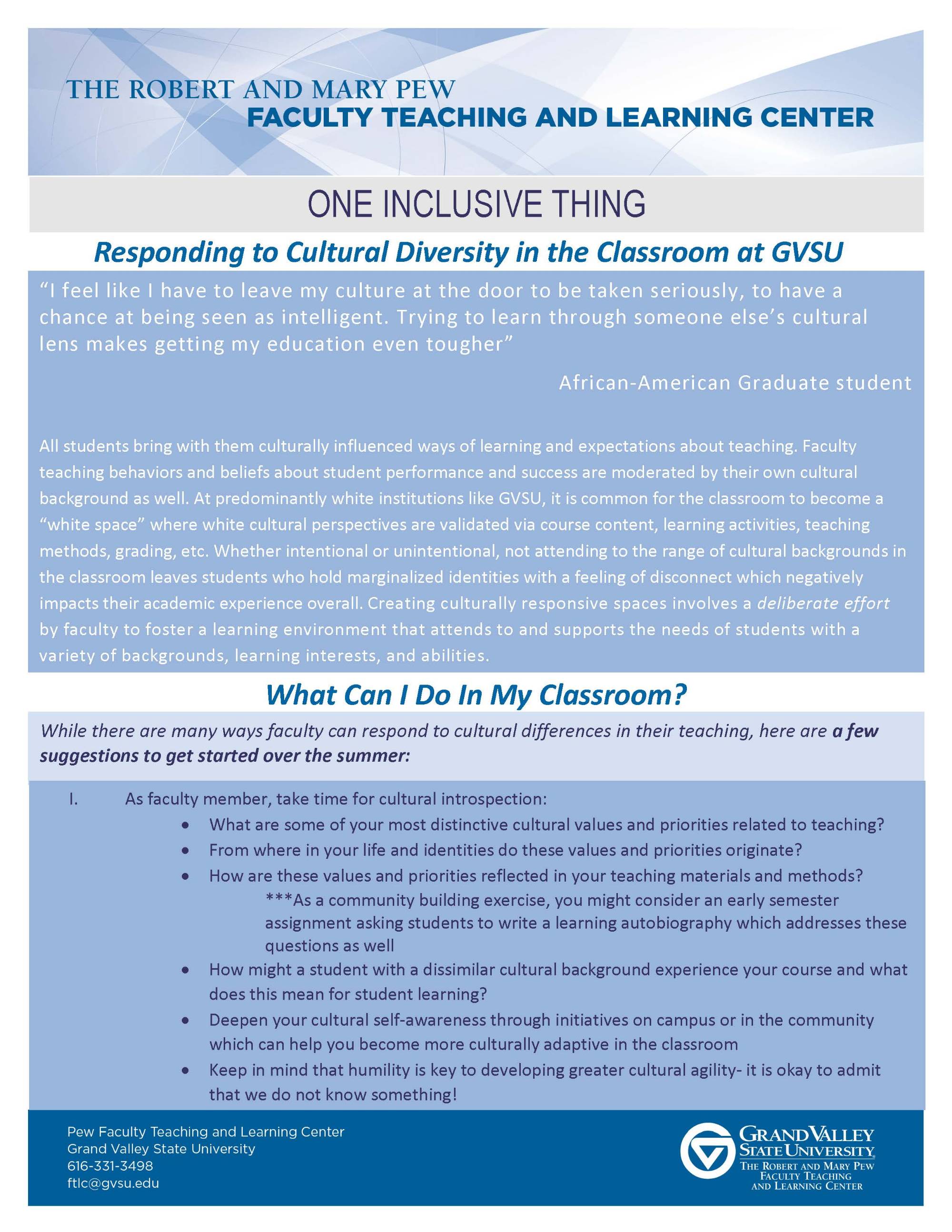Getting Started with Inclusive Teaching
Universal Design for Learning (UDL)
UNIVERSAL DESIGN FOR LEARNING (UDL) (PART 1): DEFINITION AND EXPLANATION
UNIVERSAL DESIGN FOR LEARNING (PART 2): UDL GUIDELINES
UNIVERSAL DESIGN FOR LEARNING (PART 3): ENGAGEMENT STRATEGIES
UNIVERSAL DESIGN FOR LEARNING (PART 4): REPRESENTATION STRATEGIES
UNIVERSAL DESIGN FOR LEARNING (PART 5): ACTION AND EXPRESSION STRATEGIES
UNIVERSAL DESIGN FOR LEARNING (PART 6): CULTURALLY DIVERSE LEARNERS
Inclusive Teaching Tips and Strategies
Inclusive teaching involves a deliberate effort by faculty to create a learning environment that attends to and supports the needs of students with a variety of backgrounds, learning interests, and abilities. Inclusive pedagogical strategies shape the dynamics in teaching-learning spaces, affect an individual's experiences in those spaces, and influence course and curriculum design. Inclusive teaching attends the range of identities in the classroom and helps all students feel equally valued.
As you think ahead to next semester, here are a few questions to consider:
- Does your syllabus portray an inclusive and welcoming learning environment?
- Do you have a plan for getting to know students and fostering student-student interaction?
- Do your instructional strategies include basic Universal Design for Learning (UDL) concepts?
- Do you have a plan for disseminating content in multiple ways such as printed text, images, audio and video vs just lecturing from slides?
- Will you provide students with multiple ways to express their comprehension and mastery of topics vs just assigning lengthy exams and papers?
- How do you plan to tap into students' interests, challenge them appropriately, and motivate them to learn?
ONE INCLUSIVE THING:
Responding to Cultural Diversity in the Classroom at GVSU
2019, Issue 3
Click the image above to download the PDF version
Resources
University of Michigan:
Creating Inclusive College Classrooms is a comprehensive discussion about and step-by-step guide to creating classrooms in which all students feel empowered to participate and issues are viewed from multiple perspectives. Sections of this essay address choosing course content, examining prior assumptions of multicultural issues and how they manifest in classrooms, and considerations for class interactions.
The Research Basis for Inclusive Teaching provides citations for the wealth of studies that support creating inclusive classrooms to support the learning of all students.
CAST:
Universal Design for Learning recommends ways that courses and classrooms can be designed to address diverse learning styles and needs.
Faculty Focus Article - "Steps Toward Creating A More Accessible and Inclusive College Classroom" (May 19, 2025)
Dr. Bernice Sandler, Women's Research and Education Institute:
The Chilly Climate is Dr. Bernice Sandler's compendium of ways that women are treated differently than men in college classrooms. The site contains examples of the "Chilly Climate" and how it affects women, and ideas for both faculty and students to warm up the chilly classroom climate for women.
Grand Valley State University:
GVSU's Student Accessibility Resources also has information and resources for assisting students with disabilities.
The Multicultural Pavilion:
The Multicultural Pavilion offers an archive of Awareness Activities including ways to prepare for teaching multicultural issues, icebreakers, and introspective activities. The Pavilion also offers an Education Equity Awareness Quiz, and recommendations for faculty: 20 Things I Can Do To Be a Better Multicultural Teacher.
National Council of Teachers of English:
Guidelines for Gender-Fair Language. Your syllabus is a great place to model inclusivity. Language is a powerful tool - use it wisely in your written materials as well as in your dialogue with students.
Purdue University:
The Center for Instructional Excellence at Purdue University Global Learning Faculty Development webpage provides faculty with teaching tips, resources and tools, including sample “starter kit” assignments, to assist them in introducing the first steps for idea development when teaching intercultural learning. These resources map the process of learning to the intercultural attitudes, skills, and knowledge, using Bloom’s Affective Domain of learning, to the Association of American Colleges & Universities VALUE Rubric Development Project.
Oakland University:
The Center for Excellence in Teaching and Learning at Oakland University has a rich Universal Design for Learning resource page with quick guides, 5-minute videos, teaching tips, and links to sample assignments.
University of Illinois:
Some Very Basic Tips for Making Higher Education More Accessible to Trans Students and Rethinking How We Talk about Gendered Bodies provides suggestions for creating an inclusive classroom for transgender and gender nonconforming students.
Additional Resources:
Interactive tools and resources on implicit bias from the Kirwan Institute for the Study of Race and Ethnicity at Ohio State University.
Gender Bias In Academe: An Annotated Bibliography of Important Research Studies


